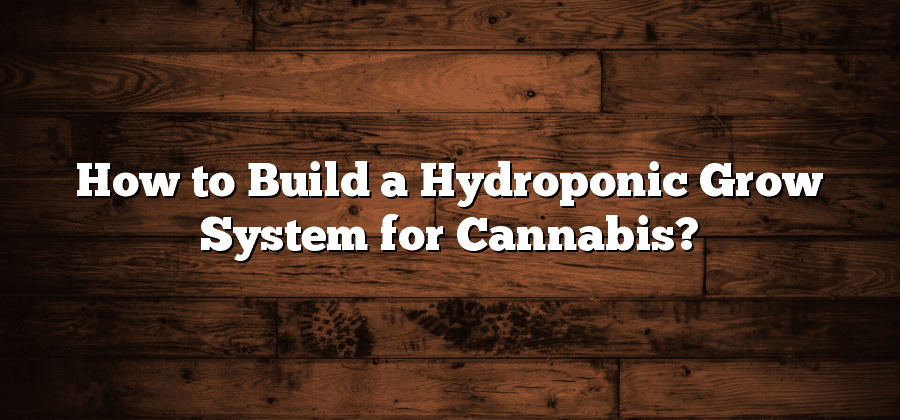Understanding the Benefits of Hydroponic Growing for Cannabis
Hydroponic growing has gained significant attention in the realm of cannabis cultivation due to its numerous benefits. One of the key advantages of hydroponics is the ability to closely monitor and control the plant’s growing environment. By eliminating soil from the equation, growers have the power to manipulate every aspect of the plant’s surroundings, including temperature, humidity, and nutrient levels. This precise control allows for optimal growth conditions, resulting in healthier and more productive cannabis plants.
Another benefit of hydroponic growing for cannabis is the potential for faster growth and higher yields. With hydroponics, plants have direct access to water and nutrients, enabling them to grow at an accelerated rate. Additionally, the controlled environment minimizes the risk of pests and diseases, reducing the need for pesticides and ensuring the plants remain in peak health. As a result, hydroponic systems have the potential to produce significantly larger yields compared to traditional soil-based cultivation methods.
Selecting the Right Location and Environment for Your Hydroponic Grow System
One of the key factors in successfully implementing a hydroponic grow system for your cannabis cultivation is selecting the right location and creating an ideal environment. The location you choose should provide adequate space for your hydroponic setup and allow for easy access to water and electricity. Additionally, it’s essential to consider factors such as temperature, humidity, and ventilation in order to create the optimal growing conditions for your plants.
When evaluating potential locations for your hydroponic grow system, you should look for a space that can be easily controlled and regulated. This includes being able to adjust the temperature and humidity levels to meet the specific needs of your cannabis plants. It’s also important to consider the availability of natural light, as well as the potential for unwanted pests or diseases in the surrounding area. By carefully selecting the right location and creating the ideal environment, you can maximize the potential of your hydroponic grow system and achieve optimal cannabis growth.
Exploring Different Hydroponic Systems for Cannabis Cultivation
When it comes to cannabis cultivation, hydroponic systems offer a versatile and efficient solution for growers. These systems eliminate the need for soil by providing plants with a nutrient-rich water solution, allowing them to grow faster and produce higher yields. There are several different types of hydroponic systems available, each with its own benefits and considerations.
One popular hydroponic system for cannabis cultivation is the deep water culture (DWC) system. In this system, plants are suspended in nutrient-rich water with the roots submerged. Oxygen is provided through air stones or diffusers, ensuring that the roots have access to ample oxygen. This system is easy to set up and maintain, making it a great option for beginners. Another system to consider is the nutrient film technique (NFT) system. This system involves a thin film of nutrient solution running over the roots, providing a constant supply of nutrients. NFT systems are efficient and water-saving, making them a popular choice for growers with limited water resources. Overall, the choice of hydroponic system will depend on the specific needs and preferences of the grower.
Choosing the Ideal Lighting Setup for Your Hydroponic Cannabis Grow
When it comes to growing cannabis hydroponically, selecting the right lighting setup is crucial for achieving optimal results. The lighting system you choose will directly impact the growth and development of your plants, so it’s essential to make an informed decision. There are a few key factors to consider when choosing the ideal lighting setup for your hydroponic cannabis grow.
First and foremost, you’ll need to determine the type of light source you want to use. The two most common options are LEDs (Light Emitting Diodes) and High-Intensity Discharge (HID) lights. LEDs are known for their energy efficiency and long lifespan, making them a popular choice among hydroponic growers. On the other hand, HID lights offer a broader spectrum of light, which can be beneficial for cannabis plants during different growth stages.
Additionally, you’ll need to consider the wattage of the lights and the coverage area they can adequately illuminate. Different strains of cannabis have varying light requirements, so it’s important to match the wattage of your lights to the needs of your specific plants. Furthermore, the size of your growing space will also impact the number and layout of lights you’ll need. Proper positioning of the lights is essential to ensure even light distribution and maximum exposure for your plants.
In conclusion, selecting the ideal lighting setup for your hydroponic cannabis grow requires careful consideration. By understanding the type of light source, wattage, and coverage area needed, you can create the perfect environment for your plants to thrive. Choosing the right lighting setup is a critical step towards achieving healthy, high-yielding cannabis crops.
Selecting the Right Nutrient Solution for Optimal Cannabis Growth
A crucial factor in achieving optimal cannabis growth in a hydroponic system is selecting the right nutrient solution. The nutrient solution serves as the primary source of essential elements that the plants need for proper development and overall health. Unlike traditional soil-based cultivation, where nutrients are found in the soil, hydroponic systems require a carefully balanced nutrient solution that can be easily absorbed by the plant roots.
When choosing a nutrient solution for your cannabis grow, it is important to consider the specific needs of the plant at each stage of its growth cycle. Different nutrients are required during the vegetative phase compared to the flowering phase, and using a nutrient solution tailored to these specific needs can greatly enhance the overall yield and quality of the final product. Additionally, being aware of any deficiencies or imbalances in the nutrient solution and making the necessary adjustments can help avoid plant health issues and maximize growth potential.






